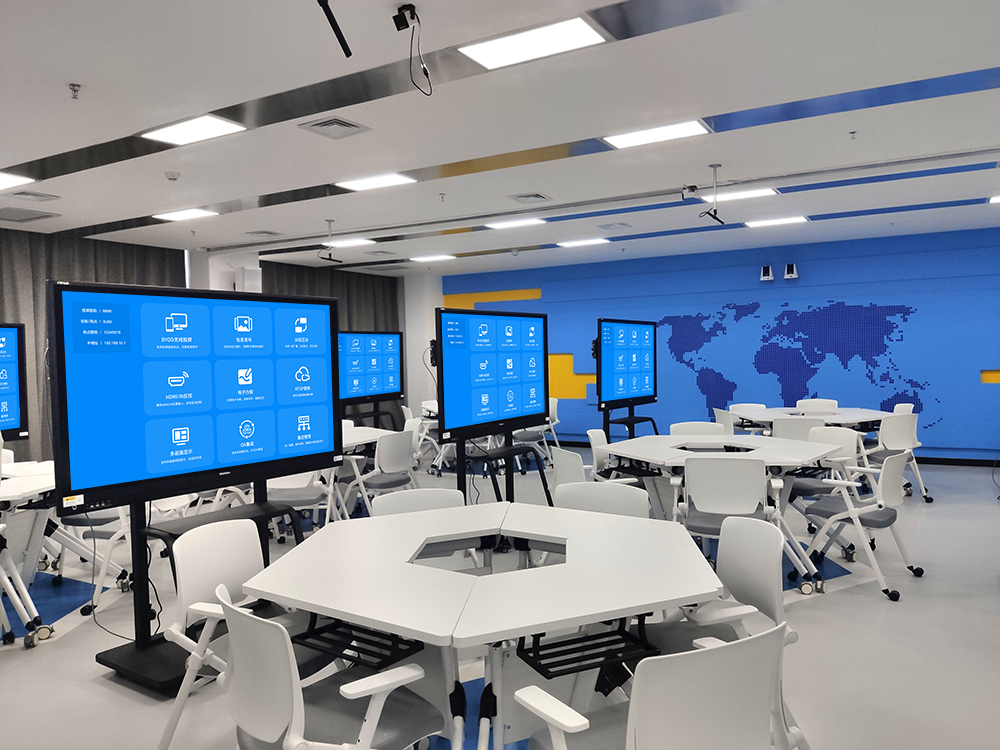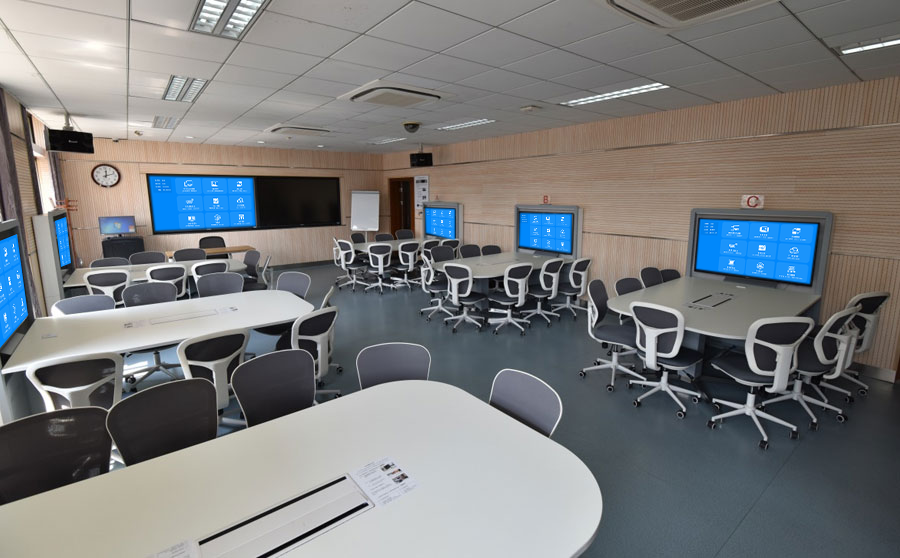Interactive Classrooms: Bringing Lessons to Life
Do you want to move beyond the problems of “single-screen mirroring and weak teacher-student interaction” in interactive classrooms? This screen mirroring software is the solution. Using the precise pushing benefits of DLNA and multi-device collaboration, it enables segmented lesson pushing, flexible work displays, and mutual control between teachers and students. It’s perfect for all educational levels, from primary school to university, and helps a classroom move from “one-way lecturing” to “two-way interaction.”
3 Steps to a Quick and Easy Interactive Classroom
You don’t need to do any complex upgrades. Just follow these simple steps:
- Network and Device Activation: The teacher’s computer or tablet, students’ phones or tablets, and the classroom’s main screen and group screens all connect to the campus Wi-Fi. Open the mirroring software, and it will automatically activate the DLNA receiving function. Devices will be identified by category, like “Teacher Device,” “Student Device,” or “Display Device.”
- Tiered Permissions: The teacher can enable “DLNA Presenter Permissions” in the software (allowing them to push lessons and control the pace). Students can scan a code to get “DLNA Participant Permissions” (allowing them to push their work and ask questions) to prevent unwanted content from interfering.
- Start Interactive Teaching: Tap “Start Interactive Class.” The teacher’s device, students’ devices, and the display will all connect in under 10 seconds. Lessons, homework, and annotations will be pushed precisely with DLNA. The whole process takes less than 1 minute.
Core Functions for Deeper Interaction
Pushing Lessons: Segmented, Focused, and Precise
- DLNA Segmented Lesson Pushing: A teacher can use their computer to break a lesson down into modules like “Concept Explanation,” “Case Study,” and “Class Practice,” then push one module at a time with DLNA, which keeps students from getting distracted. When pushing animations or lab videos, it supports fast-forwarding and pausing for flexible control that helps students understand better.
- Multi-Device Lesson Sync: The content a teacher pushes to the screen will automatically sync to students’ tablets, so they can review it after class. When students find a key point, they can take a screenshot with their phone, annotate it, and push it to their group’s side screen with DLNA for a more focused discussion.
- Targeted Audio Pushing: When a teacher needs to play an audio reading in a language class or listening materials in an English class, they can use DLNA to push the audio directly to the classroom’s sound system. The sound quality is clear with no static, so students in the back can hear clearly without needing to turn up the volume.
Showcasing Work: Flexible Pushing for All
- Quick DLNA Pushing: After a group discussion, students can use their phones or tablets to push a photo of their homework, a mind map, or their problem-solving steps to their group’s side screen with DLNA for peer feedback. The teacher can then select the best work and push it to the classroom’s main screen for the whole class to critique, which avoids the awkwardness of “holding up your device to show everyone.”
- Multi-Group Split-Screen: It supports 2-4 groups pushing their work to the main screen with DLNA for a split-screen display (e.g., Group 1’s proposal on the left, Group 2’s ideas on the right). This makes cross-group comparisons intuitive and encourages a friendly competition, making the class more engaging.
- Save Work with a QR Code: Students’ work can be turned into a QR code after it’s been displayed, and students can scan the code to save all the groups’ work. They don’t have to ask for the materials one by one after class.
Teacher-Student Interaction: Real-Time and Precise
- Teacher Remote Control: A teacher can use their tablet to remotely control the pace of a student’s presentation with DLNA. If a student pushes the wrong content, the teacher can instantly pause it and point out the mistake, which helps a student correct themselves. When a teacher is explaining a student’s work, they can use DLNA to zoom in on a key point (like a formula in a problem-solving process) so the whole class can see it more clearly.
- Student Questions: When a student is confused, they can annotate their tablet with a question (e.g., “I don’t understand this formula”) and push it to the teacher’s device with DLNA. The teacher can then address the question, which prevents students from being “afraid to ask questions” or letting them pile up.
- Real-Time Annotation Sync: A teacher can use a handwriting tablet to annotate key points on the main screen, and the annotations will be synchronized to all students’ devices with DLNA. Students can also add their own annotations on their tablets and push them to their group’s side screen, making teacher-student and student-to-student interaction more thorough.

Versatile for All Educational Levels
Primary/Secondary School: Fun and Engaging Lessons
- In a math class, a teacher can use DLNA to push a lesson on geometric shapes. Students can use their tablets to drag the shapes to demonstrate a proof, then push their work to the main screen. This makes abstract concepts tangible.
- In a science class, a teacher can push a video of a lab procedure. Students can then work in groups to perform the lab and use their phones to record their process and push it to their side screen. The teacher can then remotely critique their technique, making the lab both safe and efficient.
Vocational/Higher Education: More Intuitive Hands-On Learning
- In a class on automotive repair or mechatronics, a teacher can use DLNA to push a video of a device being disassembled to the main screen, and students can follow along. When a student has a question, they can take a photo of their process with their phone and push it to the teacher’s device, so the teacher can guide them without having to check on each student individually.
- In a design class, a student can use their computer to create a design, then push it to the main screen with DLNA. The teacher can then use a handwriting tablet to annotate suggestions (like “adjust the color scheme”), which makes fine-tuning more precise.
University: Deeper Discussions
- In a professional course, a teacher can push a part of a research paper to the main screen. Students can annotate their thoughts on their tablets and push them to their group’s side screen with DLNA for an in-depth discussion. After the discussion, they can compile different points of view and push them to the main screen for a class debate, which helps develop critical thinking.
- During a graduation project advising session, a student can push their design proposal to the main screen with their computer. The teacher can then push reference examples with DLNA to compare them and give more targeted advice.
Simple and Secure Management
- Permission Control: You can set permissions like “only teachers can push lessons during class” or “student pushes must be approved,” which prevents students from pushing unwanted content. You can also create DLNA device groups by class, so devices from different classes don’t interfere with each other.
- Trackable Mirroring History: The software automatically records every DLNA push and student presentation. A teacher can review the history to analyze the effectiveness of the interaction, and parents can use a link shared by the teacher to see how their child performed in class.
- Stable Transmission: It uses DLNA protocol optimization technology, so when multiple devices are pushing content at the same time, latency is less than 20ms, and the disconnection rate is less than 0.1%. When the campus network is unstable, it supports “push from where you left off,” so lessons and student work are not lost, and teaching is not interrupted.
The software is compatible with both new and old devices, and the installation package is only 80MB, so it runs smoothly without using up too much memory. Whether it’s for a daily lesson, a public lecture, or a hands-on training, using this screen mirroring software to create an interactive classroom will make teacher-student interaction more thorough and teaching more efficient, helping to improve the quality of education.